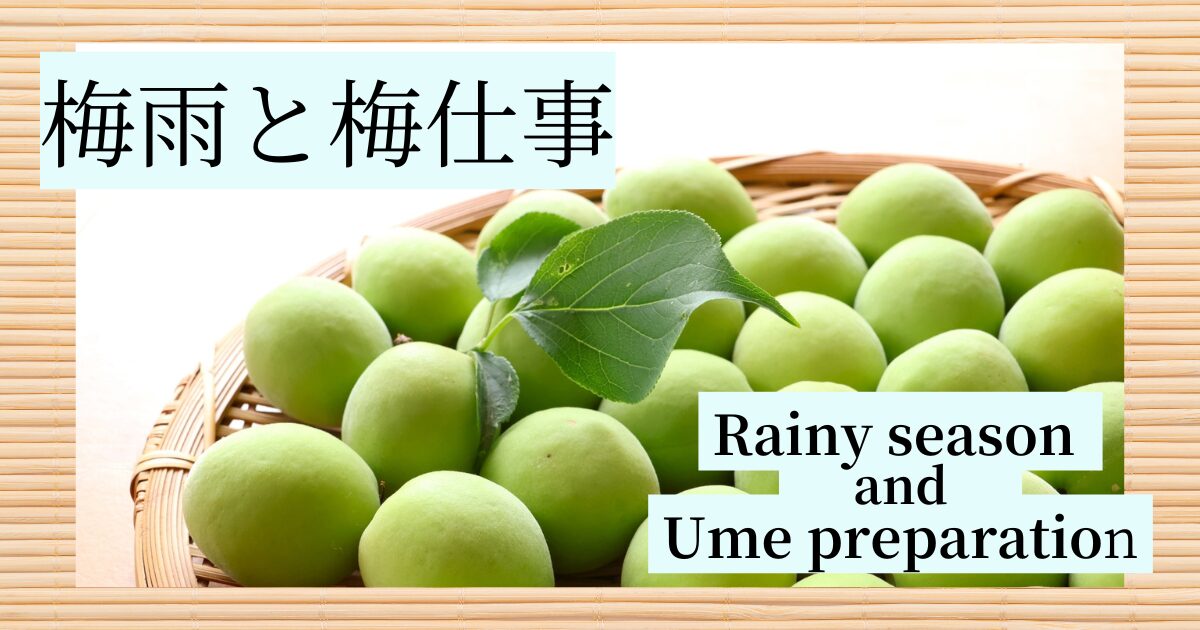日本語で雨季は梅雨と書きます。「梅」の字が入っている通り、この時期スーパーにたくさんの梅が並び、梅の甘酸っぱいおいしそうな良い香りが広がります。いつもこの香りを保存できないものかと思います。
我が家でも祖父から梅をいただき、梅干しと梅ジュースを作ります。海外の方に梅干しの作り方を紹介したくて一生懸命説明するのですが、上手く伝わっている気がしない。あれ?梅って海外に存在しないの?
いえいえ、正確には、日本の梅と種類が違うみたいですね。
In Japanese, rainy season is written as “梅雨 “. As this word includes the character “梅 “, many ume plums are lined up in supermarkets during this season. The nice, sweet, and sour aroma of them fills the air. I always wish it were possible to preserve this fragrance.
My family also make umeboshi and ume-juice using my grandfather’s ume plum. I try to explain how to make umeboshi to people abroad, but I don’t feel like I am getting the word across well. Huh? Ume plum doesn’t exist abroad?
No, no, to be precise, the type of plum is different from the ume plum in Japan.
梅仕事の季節
日本での雨季は6月。雨季を指すつゆはもともと黴雨(カビの雨)と書いていたものを梅の実る時期であることから梅雨(梅の雨)に替えたと言われています。この時期とれる青梅をつかって梅干しやジュース、梅酒などをつくります。これが梅仕事。青梅はそのままでは食べれませんよ。
梅自体はもともと中国原産。はじめは杏子や桃のように生菓子に加工して食べていたものが、次第にその効用が知られるようになり、薬や保存食として用いられるようになりました。
参考:https://www.umekenkyuukai.org/knowledge/history.html
そう、日本人があの酸っぱい梅干を食べているのには訳があるのです。梅は薬にもなるのです。
The season of preparation of Ume plum
The rainy season in Japan is in June. The word “梅雨” which refers to the rainy season, was originally written as “黴雨 mold-rain”, but was changed to “梅雨 ume-rain” because this is ume plum harvest time. By using the ume plum, we make umeboshi, ume-juice, ume-shu. This is ume preparation. Don’t eat fresh green ume plums .
The ume plum is originally from China. At first, people used it to make sweets, like apricots and peached, but gradually its benefits become known and it came to be used as a medicine and preserved food.
https://www.umekenkyuukai.org/knowledge/history.html
Yes, there is a reason why Japanese people eat those sour pickled plums, umeboshi. Ume plum can be a medicine too.
梅干しの作り方
日本食として有名な梅干し、どうやって作るのでしょうか?
- 黄色くなった梅を洗いへたを取る
- 焼酎をふりかけ容器や梅を殺菌し、梅と天日塩を交互にして入れる
- 2-3日重石を置いて梅酢と呼ばれる水分が上がってきたら、塩もみしてアクを抜いた赤紫蘇を投入。
- 2-3週間待って梅雨が明けたら乾かす
塩と赤紫蘇は大体梅の20%くらいを目安にします。必ず天然塩を使ってくださいね。梅干しは保存食として何年も保存可能です。時間がたてばたつほどおいしくなります。よくはちみつを混ぜた梅干しが売っていますが、時間がたった梅干しからはそれに似た甘みが出てきます。
How to make umeboshi
How do we make umeboshi, a famous Japanese food?
- Wash yellowed ume plums and remove the stems.
- Sterilize the container and ume plums by strong liquor, and put the ume plums and sun-dried salt alternately.
- When the water called ume vineger rises,put red shiso which has been blanched with salt to remove the scum.
- Wait 2-3 weeks and when the rainy season ends, dry outside.
Salt and red shiso should be roughly 20% of the ume plum. Be sure to use natural salt. Umeboshi can be stored for years as preserved food. The longer they are stored. the tastier they become. You may have seen umeboshi with honey in supermarket. After time, umeboshi will develop a sweetness similar to that.
海外で梅干しは作れるのか?
梅干しは殺菌作用になり、お弁当が傷むのを防いでくれます。また、食べることでも食中毒を防止したり、風邪に効いたり、疲れを取ったり、そもそもおいしい。そんな梅を海外でも食べたいと思うのは自然なこと。海外で作ることは可能なのでしょうか。
実は簡単なようで難しい。なぜなら梅干しの3大材料、梅、塩、赤紫蘇のうちの二つ、梅と赤紫蘇が手に入らないのです。
では代替品になるものはないのか?
アプリコット…風味は違うがおいしい
プラム…酸味のあるものを選ぶ
ビーツやザクロ…色は着く
私は試したことはないので、どなたか試した方がいれば教えてください。その国その国で薬になる伝統食があります。日本に来た場合はぜひおいしい梅料理を楽しんでください。
Can I make umeboshi outside of Japan?
Umeboshi has antimicrobial effects and prevent damage to food. Eating them also prevent food poisoning, helps with colds, relieves fatigue, and they are nice rice buddy to begin with. It is natural to want to eat such food everywhere. Is it possible to make them outside of Japan?
Actually, it seems easy, but it is difficult. Because two of the three main ingredients for umeboshi – plums and red shiso – are unavailable.
So, is there anything that can be substituted?
Apricot…different flavor but tasty
Plum… try to choose sour ones
Beet or Pomegranate…They can put color
I have never tried them, so if anyone has, please let me know. There are traditional foods that are medicinal in each country. If you come to Japan, enjoy delicious ume plum dishes.




コメント